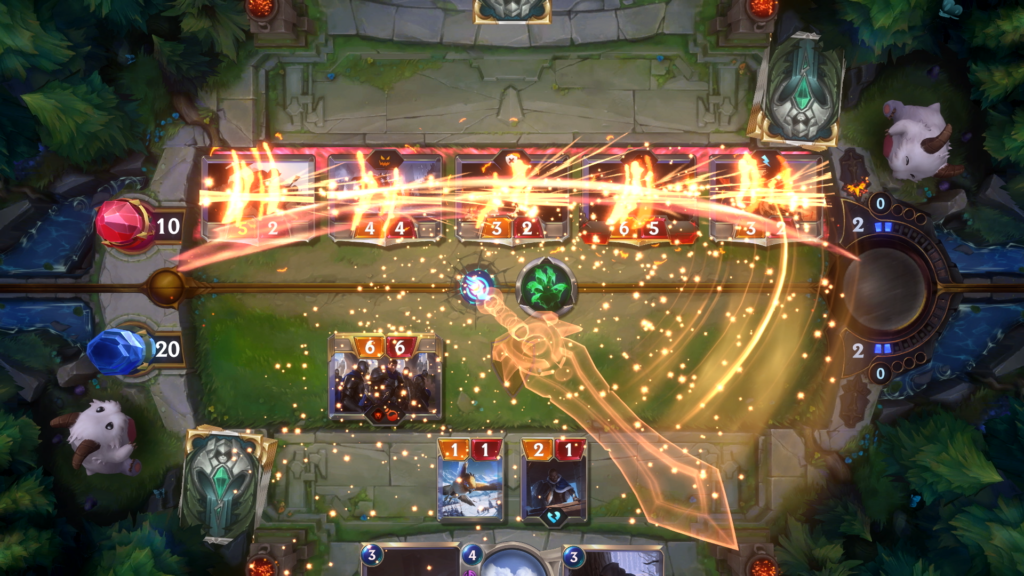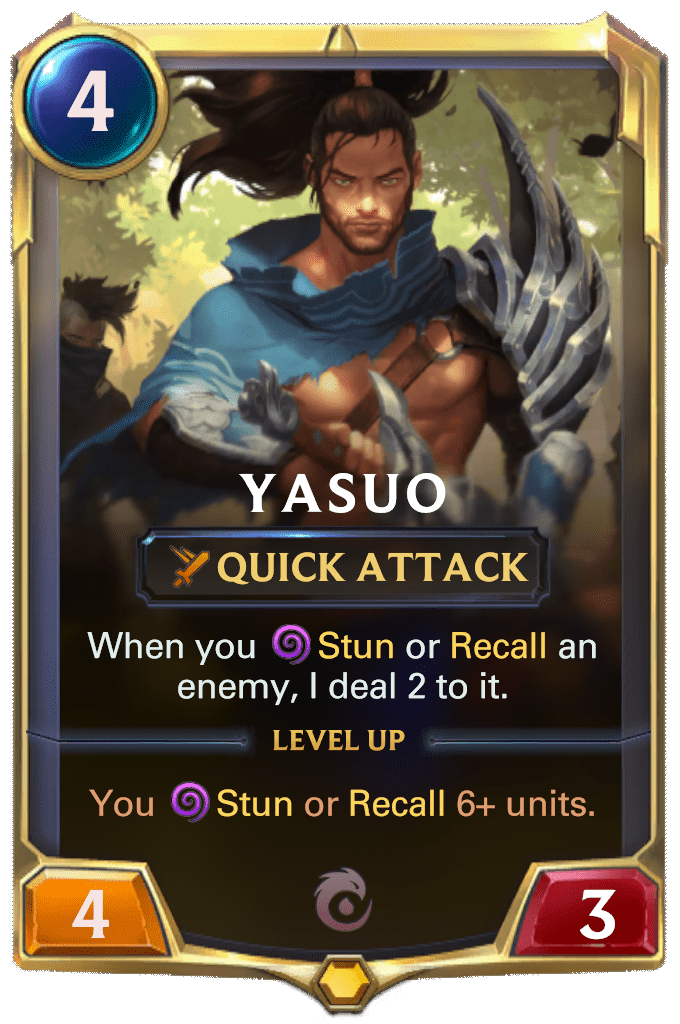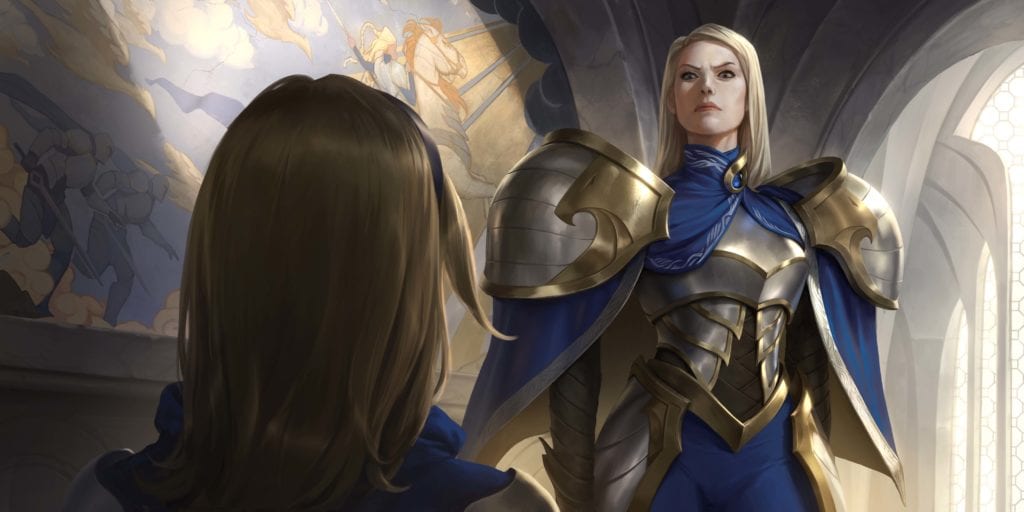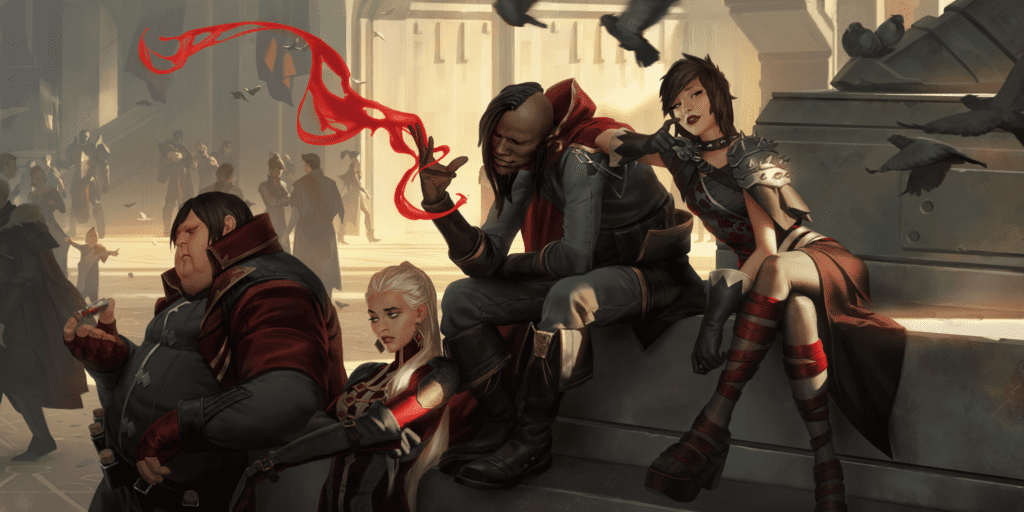At EGX 2019, we sat down with Steve Rubin, game designer and live balance lead at Riot Games for Legends of Runeterra, the newly announced card game.
The plan was to discuss what sets the card game apart from others on the market and what it’s all about. We did that, but we also ended up discussing interesting aspects of League of Legends lore, how it could crossover from game to game, and if we could see the new followers in Runeterra (like one of Vladimir’s Crimson followers who’s already been well-received online) become fully fledged champions in League of Legends in the future…
What’s your background at Riot?
I was brought on to Riot specifically for the project. I’ve been at Riot full-time for two years. Three years ago, they hired me and some other Magic the Gathering professional players – which is my background in CCG (collectible card games) – to test out what they had.
It was different to what we have now. I was the first non-Rioter to playtest a Riot R&D (research and development) games.
What’s it been like working on a project in secret for years?
It’s actually pretty crazy, I’ve kind of been living in stealth mode. When I moved to LA, I was a pro Magic player and had no previous games dev experience.
My friends were like: ‘Oh you must be making a card game.’
And I was like: ‘No, I don’t know what you’re talking about!’
I didn’t even post on social media that I was moving. Now it’s awesome to be here and be able to say Legends of Runeterra, I’m not living a secret life anymore!
“In a lot of games you have to buy $150 worth of packs just to play a deck and be competitive. We’re kind of saying screw that. There are wild cards you buy directly, and the Vault, which offers rewards based on how much you play.”
STEVE RUBIN, RIOT GAMES
Aside from the playtesting, how have you been developing the game?
I work on our card content team, doing set design, so everything from creating champions, figuring out the champion line-up, creating spells, also as a game designer on our team, we share the burden of making the game systems so I work a bit on that.
Specifically, I work on live balance, so getting preparations for the live service starting next year. I work on the Expeditions gameplay mode, a limited mode where you draft cards offered to you. So instead of bringing a deck, you select your deck as you go, and that will drop in our November patch preview.

Tell us about Legends of Runeterra and what sets it apart from other card games on the market?
The biggest thing about Legends of Runeterra is the card accessibility. We have an entirely free-to-play model where we have this thing called The Vault every week.
To pre-face, a lot of people at Riot are players, we’ve played Magic, Hearthstone, Gwent, Elder Scrolls, Shadowverse, we really like card games and we’ve learned what’s not worked and what has, and we want to do it the Riot way.
One of those things is card accessibility, where in a lot of games you have to buy $150 worth of packs just to play a deck and be competitive. We’re kind of saying screw that, and the way we do that is through a few things.
The first thing is through the Vault, a system where as you play each week, your Vault levels up, then at the end of the week, you get a reward chest that scales based on how much you play. It’s like a free booster box, the more you play, you get more stuff. You also have region rewards – there are six regions and you can select one to level up. You get XP as you play and get cards from that region.
For those who want to buy, we have wild cards which you can purchase directly. So you can get any card in the game just by buying it.
The point is, when you’re playing Legends of Runeterra, you never have to pay to randomly open cards, you can directly get what you want. So every card is worth the same amount. We have no packs. So it’s entirely free-to-play.
At Riot we believe that everyone should be on a fair playing field whether they pay or not. We cap the amount of wild cards that players can buy per week. So we’re trying to eliminate that initial advantage that monetised players get.
“If players think there are characters in the game that really resonate with them, we could develop them into champions. Lux’s Aunt was developed for Legends of Runeterra and has now been kind of cross-used in League of Legends (via the comics). That’s stuff we’re definitely looking to do in the future.”
STEVE RUBIN, RIOT GAMES
It sounds like it’s going to be a level playing field, so the talented players – it could be easier for them to rise to the top.
We wanted to completely remove cost as a barrier to entry. There shouldn’t be a pay-to-win advantage for any game we produce, like League of Legends.
One thing I want to tell fans of League of Legends and fans of games is that we aren’t trying to saturate the card game market, we’re trying to bring card games to new players.
We love strategy games and I think more people would be into them if they were more accessible. We’re launching on PC, iOS and Android when we launch next year because we want card games to be for everyone. There will be a closed beta for PC in January 2020.
In November 2019 there will be a patch preview. I’ve been working on Expeditions and we’re going to be launching that feature. We’re doing some new things in that mode and if you watch the trailer, there is a few seconds where you can see what the limited mode is like.
Do you have any plans on the esports side for Legends of Runeterra or is it too early to say at this stage?
It’s a bit early but our plan is to gauge players’ reactions to our game and see what they want. A good example is with League of Legends, we didn’t create esports, we let the players decide what they wanted then organically built on top of that.
Our plan is the same with Legends of Runeterra. If we see it’s a player need, then we’ll definitely support that need. For now we don’t have any specific plans for tournaments or anything like that, but it doesn’t mean we’re not watching to see what players want.
That’s one of the big reasons we’re doing these preview patches. Do players want to see this in the game, do they want more champions, do they want modes like Clash? Then we can look to start developing those features.
You have some big streamers covering Legends of Runeterra already like Disguised Toast and Kripparrian. What’s it like being involed with them?
It’s been pretty awesome. I think Riot tries to develop relationships directly with streamers because they’re players and sometimes even represent players because they have a wide audience.
Seeing people excited about our multi-game future is really awesome. What’s awesome about Legends of Runeterra is our League of Legends IP (intellectual property). So many players know and identify with it. I saw a strategy game/card game streamer saying he now wants to play League of Legends so he can get to know the characters and get immersed in it. That’s really cool to see players like that excited t hat way.

What kind of cards are there in Legends of Runeterra?
There are units, like creatures or minions in other games. We use the terms Champions and Followers. Champions are those we know and love like Lux, Garen and so on, those core to the game. They’re very powerful. They have a unique mechanic called champion level up, they have quests and when you complete them they become even more powerful. It lets players express themselves and build decks around champions.
One of the things we’re excited about is fleshing out the world of Runeterra and having cool followers – units in the game that aren’t champions.
One that springs to mind is Tianna Crownguard – Lux’s aunt. We developed her to kind of explore what Demacia looks like, what the Crownguard family is up to, how they’re anti-magic, how does Lux interact with that… you can see Tianna in the Lux/Marvel comic. She’s a character developed for Legends of Runeterra that has now been kind of cross-used in League of Legends. That’s stuff we’re definitely looking to do in the future.
How did that come about, how does that work within Riot?
I’m not the best person to answer that, but in Legends of Runeterra we have a local narrative team on our gameplay team, who make cards and VFX. They work hard on making really well-done voice lines, they do the flavour text, interactive conversations between characters, creatures and art concepts.
That team consults with Riot’s global narrative team and trade-off assets. We make our own assets, but it’s deeply interactive between our team and the League of Legends narrative team.
“We aren’t trying to saturate the card game market, we’re trying to bring card games to new players. We want card games to be for everyone.”
STEVE RUBIN, RIOT GAMES
Are Vi or Evelynn in the game?
They’re not in the game right now.
Oh no! (laughs)
Sorry! We have 24 champions in Legends of Runeterra and as we become more multi-game it’ll be interesting to see if we’re missing champions. League of Legends has 145 champions.
To get some of these newer games started we need to have a starting point. We’re interested to see what players think about followers. We have a unique opportunity to eventually, potentially even develop our own champions. If players really identify with a character like Tianna or something like that…

So Lux’s Aunt (above) could become playable in Summoners’ Rift one day?
I can’t really answer that, but it’s something that could be cool. I think a good example from our game is Cithria, she has multiple cards. She starts off young and naive but can become Cithria the Bold (a more powerful card). If players really think there are characters in the game that resonate with them, we could develop them into champions.
The Crimson Cult (followers of Vladimir) have been very well-received by the community online in particular.
The Crimson Cult, Vladimir’s cult of followers who deal in blood magic. It has a really diverse cast and people saw that and really loved the characters. Their art is different, one guy is dealing with a blood capsure – the Crimson Curator.

It’s interesting the lore is being added to. It’s almost overwhelming, the possibilities now for the League of Legends franchise going forwards.
It’s really interesting for us, especially because when you think about in Legends of Runeterra, champions aren’t one-to-one copies of what we see in League of Legends. In League of Legends there are reworks and changes.
We take what players love about the character and design around that. In the future, as League of Legends becomes a bigger thing, you might see characters portrayed in different ways. We do that based on what players think about characters.
We have a lot of data from League of Legends, e.g. say one word to describe your character. We make a word cloud. In Legends of Runeterra, some people identify with champions mechanically, and some people identify with them thematically. Take Yasuo for example, players who like him really like his gameplay, knocking stuff up, cutting stuff down, dashing through units.
So we really tried to design Yasuo in Legends of Runeterra around those mechanics. With someone like Vladimir, they like the idea he’s this vampire blood mage that sucks the blood out of people. Sometimes players are more interested in the thematics than the mechanics. Since we’re recreating these champions we have to take these decisions into account.
So in Legends of Runeterra, Vladimir is more of a blood mage and he sucks blood out of his allies to deal damage to his enemies. It’s interesting because that’s not really how he works in League of Legends, but we’re hoping that’s true to the character and players buy into that.
Check out more about Legends of Runeterra on the game’s website
Essential UK Casino & Betting Guides
Looking for the best casinos or betting sites? Below you’ll find our recommended guides that players in the UK are loving right now.
- Top Online Casinos UK 2025
- Bitcoin Casinos to Play at in July 2025
- Best Betting Sites UK for 2025
- No KYC Casinos UK
- Best Non Gamstop Casinos 2025

Dom is an award-winning writer and finalist of the Esports Journalist of the Year 2023 award. He has almost two decades of experience in journalism, and left Esports News UK in June 2025.
As a long-time gamer having first picked up the NES controller in the late ’80s, he has written for a range of publications including GamesTM, Nintendo Official Magazine, industry publication MCV and others. He also previously worked as head of content for the British Esports Federation.

